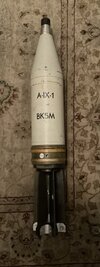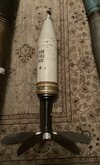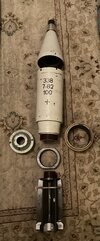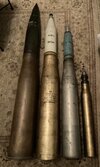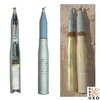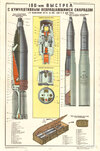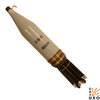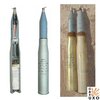British Ordnance Collectors Network
You are using an out of date browser. It may not display this or other websites correctly.
You should upgrade or use an alternative browser.
You should upgrade or use an alternative browser.
Russian
- Thread starter Tuney
- Start date
wingsofwrath
Well-Known Member
I see the cartridge case is Russian, but the projectile itself is Polish, as evidenced by the fact it's marked in the Latin alphabet and has the factory code "338", which is something I've seen before on Polish projectiles. See the one on the right in th picture.
Attachments
It’s a Russian BK5MI see the cartridge case is Russian, but the projectile itself is Polish, as evidenced by the fact it's marked in the Latin alphabet and has the factory code "338", which is something I've seen before on Polish projectiles. See the one on the right in th picture.
wingsofwrath
Well-Known Member
No, it's not.
As I said, it's a Polish BK5M projectile mated to a Soviet cartridge case.
You can tell it's Polish because it says on it "BK5M" instead of "БК5М" as it would be in Russian and the factory code is "338" which, again, I've only seen on Polish projectiles .
Incidentally, the whole cartridge is named "UBK4", or in Russian, "УБК4"
Here is what the proper Russian inscription in Cyrillic looks like - it is either "БК5М" or, in some cases, "ЗБК5М" ( "ZBK5M").
As I said, it's a Polish BK5M projectile mated to a Soviet cartridge case.
You can tell it's Polish because it says on it "BK5M" instead of "БК5М" as it would be in Russian and the factory code is "338" which, again, I've only seen on Polish projectiles .
Incidentally, the whole cartridge is named "UBK4", or in Russian, "УБК4"
Here is what the proper Russian inscription in Cyrillic looks like - it is either "БК5М" or, in some cases, "ЗБК5М" ( "ZBK5M").
Attachments
That is not not "Z" but a 3 as it is the main group in the GRAU inventory for ammunition.some cases, "ЗБК5М" ( "ZBK5M").
wingsofwrath
Well-Known Member
Good to know! Interestingly, some Russians themselves don't understand that is supposed to be a "3" and not a "Z", because I've seen it referred as "ЗБК5М" ("ZBK5M") in numerous places on the internet.
I think what makes the confusion worse is the fact the whole cartridge has the prefix "У" ("U"), so it's easy to assume it's also a letter instead of a digit for the projectile.
EDIT: You want to know the kicker? I checked my files and the folder relating to this projectile is labelled correctly, "3BK5", with a "3" so I absolutely knew that at some point. I blame the chemotherapy drugs, they might have saved my life, but they've made my mind a sieve in the last couple of years... Well, better than the alternative, I guess.
I think what makes the confusion worse is the fact the whole cartridge has the prefix "У" ("U"), so it's easy to assume it's also a letter instead of a digit for the projectile.
EDIT: You want to know the kicker? I checked my files and the folder relating to this projectile is labelled correctly, "3BK5", with a "3" so I absolutely knew that at some point. I blame the chemotherapy drugs, they might have saved my life, but they've made my mind a sieve in the last couple of years... Well, better than the alternative, I guess.
Last edited:
It’s a Russian BK5M
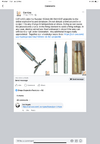
On the numerous stamps the shell has all over the place these are just two stamped on every single part including fins K T also every part dated 9.82 . I’ve looked on CATUXO web page and internet I can’t find any of these rounds made by Poland or even Poland having them do you have any pics or proof this is not Russian . I have learned that Poland did have these when it was part of the USSR so What stamps on the metalwork will determine Russian made or polish made ?No, it's not.
As I said, it's a Polish BK5M projectile mated to a Soviet cartridge case.
You can tell it's Polish because it says on it "BK5M" instead of "БК5М" as it would be in Russian and the factory code is "338" which, again, I've only seen on Polish projectiles .
Incidentally, the whole cartridge is named "UBK4", or in Russian, "УБК4"
Here is what the proper Russian inscription in Cyrillic looks like - it is either "БК5М" or, in some cases, "ЗБК5М" ( "ZBK5M").
Last edited:
Poland was not a part of USSR, but produced by licenses different ammo and marked it by own stamps. As for me BK5M also does not looks like Soviet style marking, which in some reasons made by Latinic.View attachment 200396
On the numerous stamps the shell has all over the place these are just two stamped on every single part including fins K T also every part dated 9.82 . I’ve looked on CATUXO web page and internet I can’t find any of these rounds made by Poland or even Poland having them do you have any pics or proof this is not Russian . I have learned that Poland did have these when it was part of the USSR so What stamps on the metalwork will determine Russian made or polish made while part of the USSR ?
Also Bulgaria produces 100-mm shell. On Belaruasian official page of the factory, where renovate ammo showed Bulgaria made shell. Could be made in Bulgaria for the USSR, like maybe 90% of soviet RPG-22 on soviet storages made in Bulgaria!
wingsofwrath
Well-Known Member
That image is taken from CAT-UXO's facebook page and shows four complete cartridges - two Soviet on the left, cutaway and complete, with cartridge markings visible but not the projectile markings and two Polish ones in-situ on the right (from what I know these were found in Iraq), with not only the same markings as your projectile including the same factory code, "338", but the same font as well. And you can tell they're Polish because the inscription on the cartridge case is also in Polish and there is no other language on Earth which uses the word "czołg", meaning "tank".On the numerous stamps the shell has all over the place these are just two stamped on every single part including fins K T also every part dated 9.82 . I’ve looked on CATUXO web page and internet I can’t find any of these rounds made by Poland or even Poland having them do you have any pics or proof this is not Russian . I have learned that Poland did have these when it was part of the USSR so What stamps on the metalwork will determine Russian made or polish made ?
I'll just add the same image again at a better resolution and you can compare and contrast the inscription on the left in Russian reading "100 - СУ и ТАНК" ( [for] 100 [mm] - Self Propelled Gun and Tank") and the right one in Polish "100 - SU i CZOŁG" ( [for] 100 [mm] - Self Propelled Gun and Tank").
And while we're talking about inscriptions, please note that your projectile is dated 1982 while the cartridge is dated 1969 - even if they were from the same country, there was little chance they belonged together.
The fact Poland isn't mentioned means nothing, because it doesn't mention my country, Romania, either, and I can tell you 100% we made this particular shell under licence until we replaced with our home-grown evolution of it, the BK-412R.
Incidentally, in the link I've sent you, also from CAT-UXO, they also give an eroneous transliteration of the shell name into cyrillic (БК-412R), which is completely wrong on two counts, because not only we haven't used the cyrillic alphabet (Old Church Slavonic) since 1860, but the final "R" should also have been "P" in cyrillic...
All of which just goes to show you how some of their information is just plain wrong and can't be taken at face value.
@Ivashkin Bulgaria also uses the cyrillic alphabet, but yes, they still produce 100mm shells at two factories, Armaco JSC and Kintex, so now you can buy them with latin inscriptions also if you so desire. It is theoretically possible they produced some for export marked using the latin alphabet even in 1982, since God only knows both we and the Bulgarians were selling these to every dictatorship under the sun, but the fact we have a picture of a complete cartridge with the same factory code - "338" clinches it for me that the projectile is, in fact, Polish.
Also, if you ever see the factory code "361", I can absolutely say that is also a Polish code, because I have a Polish 57mm S-60 with that particular marking and there's also this 122mm with it up on Bulletpicker.
Attachments
I’ve been told by most probably the best known dealer/ collector in the Uk its not polish he has also contacted his polish dealers/collector friends and they say it’s not polish also didn’t Russia supply weapons to Iraq ?That image is taken from CAT-UXO's facebook page and shows four complete cartridges - two Soviet on the left, cutaway and complete, with cartridge markings visible but not the projectile markings and two Polish ones in-situ on the right (from what I know these were found in Iraq), with not only the same markings as your projectile including the same factory code, "338", but the same font as well. And you can tell they're Polish because the inscription on the cartridge case is also in Polish and there is no other language on Earth which uses the word "czołg", meaning "tank".
I'll just add the same image again at a better resolution and you can compare and contrast the inscription on the left in Russian reading "100 - СУ и ТАНК" ( [for] 100 [mm] - Self Propelled Gun and Tank") and the right one in Polish "100 - SU i CZOŁG" ( [for] 100 [mm] - Self Propelled Gun and Tank").
And while we're talking about inscriptions, please note that your projectile is dated 1982 while the cartridge is dated 1969 - even if they were from the same country, there was little chance they belonged together.
The fact Poland isn't mentioned means nothing, because it doesn't mention my country, Romania, either, and I can tell you 100% we made this particular shell under licence until we replaced with our home-grown evolution of it, the BK-412R.
Incidentally, in the link I've sent you, also from CAT-UXO, they also give an eroneous transliteration of the shell name into cyrillic (БК-412R), which is completely wrong on two counts, because not only we haven't used the cyrillic alphabet (Old Church Slavonic) since 1860, but the final "R" should also have been "P" in cyrillic...
All of which just goes to show you how some of their information is just plain wrong and can't be taken at face value.
@Ivashkin Bulgaria also uses the cyrillic alphabet, but yes, they still produce 100mm shells at two factories, Armaco JSC and Kintex, so now you can buy them with latin inscriptions also if you so desire. It is theoretically possible they produced some for export marked using the latin alphabet even in 1982, since God only knows both we and the Bulgarians were selling these to every dictatorship under the sun, but the fact we have a picture of a complete cartridge with the same factory code - "338" clinches it for me that the projectile is, in fact, Polish.
Also, if you ever see the factory code "361", I can absolutely say that is also a Polish code, because I have a Polish 57mm S-60 with that particular marking and there's also this 122mm with it up on Bulletpicker.
wingsofwrath
Well-Known Member
Out of curiosity, did you show them only the pictures of your shell, or that of the Polish round from CAT-UXO as well?
Because I'd be very interested to see how they reached the opinion that one is not Polish when it's a) marked in Polish (you're free to find me another language on this Earth which uses the word "czołg", or even the letter "ł") b) uses the verifiably Polish factory code "361" and c) it's clear that is a complete round, because it's in situ and corroded.
In any case, I gave you accurate information as far as I know it and the only counter to that was "but someone says..." so, as far as I'm concerned, you can choose to believe whatever you wish. You know what they say about leading horses to water...
Because I'd be very interested to see how they reached the opinion that one is not Polish when it's a) marked in Polish (you're free to find me another language on this Earth which uses the word "czołg", or even the letter "ł") b) uses the verifiably Polish factory code "361" and c) it's clear that is a complete round, because it's in situ and corroded.
In any case, I gave you accurate information as far as I know it and the only counter to that was "but someone says..." so, as far as I'm concerned, you can choose to believe whatever you wish. You know what they say about leading horses to water...
@ wngsofwrath
Interestingly, not only Romania developed artillery cumulative projectiles with a non-rotating (floating) rim within the framework of the Warsaw Pact, but also the Czechoslovak Socialist Republic (CSSR). It decided not to use the license (USSR) and went the way of its own development - cumulative ammunition and resulted in the introduction of the 100mm JPrSv under the code name "Pasta", mass-produced, apparently also exported...
Akon
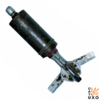
Interestingly, not only Romania developed artillery cumulative projectiles with a non-rotating (floating) rim within the framework of the Warsaw Pact, but also the Czechoslovak Socialist Republic (CSSR). It decided not to use the license (USSR) and went the way of its own development - cumulative ammunition and resulted in the introduction of the 100mm JPrSv under the code name "Pasta", mass-produced, apparently also exported...
Akon

wingsofwrath
Well-Known Member
Interesting!@ wngsofwrath
Interestingly, not only Romania developed artillery cumulative projectiles with a non-rotating (floating) rim within the framework of the Warsaw Pact, but also the Czechoslovak Socialist Republic (CSSR). It decided not to use the license (USSR) and went the way of its own development - cumulative ammunition and resulted in the introduction of the 100mm JPrSv under the code name "Pasta", mass-produced, apparently also exported...
Akon
Of course, the Czechoslovaks had even more of a reason to break with Moscow following 1968 and they were always keen to adopt their own equipment - after all, they were the only Warsaw Pact country who chose not to adopt the Ak-47 and instead went with the entirely home-grown Vz.58.
Looking at the picture, it's clear the 100mm JPrSv is entirely different from any Russian projectile - the body is shorter, the floating driving bands / gas seals are different, even the fins are a completely different design and that's before we get to the Nz-42 fuze which is an entirely Czech design.
Very unlike out own BK-412R, where it's obvious the rear part has remained unchanged from the BK-5M and only the front is different. Ours even uses the same GPV-2R fuze as the BK-5M we used to produce under licence. As they say, if it ain't broke...
Also, speaking of the Czechs, apparently they exported the licence to produce the 100mm JPrSv to Pakistan.
338 ... ZCH Nitro-Chem S.A., Poland.
361 ... ZPS Pionki Sp. z.o.o., Poland.
This is per Chis Kolls Soviet Cannon book. Never go wrong when you know the factory codes. It is also very common to see several parts made in different countries within the old Soviet Bloc. Fuzes made in country A, case in country B, and Projectile in country C, then put together and spread throughout the Soviet States. Makes knowing the codes even more important if you want to know exactly where each piece is made.
Joe
361 ... ZPS Pionki Sp. z.o.o., Poland.
This is per Chis Kolls Soviet Cannon book. Never go wrong when you know the factory codes. It is also very common to see several parts made in different countries within the old Soviet Bloc. Fuzes made in country A, case in country B, and Projectile in country C, then put together and spread throughout the Soviet States. Makes knowing the codes even more important if you want to know exactly where each piece is made.
Joe
Yes I do know that but wherever it was made it was under licence from Russia invented by Russia to be fired from Russian gunsI think Tuney does not understand the fact that russian-designed ammunition was made in other WaPa countries as well, with slight differences in regards to paint and markings. I think this is the source of his confusion.
Still, that does not make it a Russian shell, since it was made in another country (usually with some small fabricating differences) and with markings in another language.Yes I do know that but wherever it was made it was under licence from Russia invented by Russia to be fired from Russian guns


